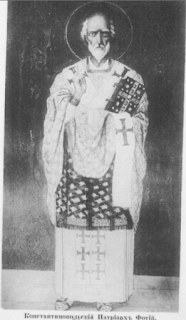The Urn of Methodius
The Chronographia of Eutychius of Morea, the 10th century Greek chronicler, is lost to us with the exception of a curious fragment preserved in the Gnomologion of the 12th century monk Sosthenes. It details an incident from the life of Saint Methodius (of Thessaloniki) which is not reported in any of the extant hagiographies. To this day there are a few villages throughout Thrace claiming to have the so-called Urn of Methodius, of which one specimen is shown above, from Obzor, Bulgaria. - A. Vernardakis
There came a day when, for our sins, strange portents appeared in the heavens and a great flaming stone plunged from the stars and crashed into the midst of a village in Thrace. From that time forth strange reports emanated from the village- sightings at night of terrifying winged beasts moving through the air, disturbing cries heard from the hillsides, disappearances of children, and blasphemous rituals held at the village's edge at midnight. Appalled by the rumor that the villagers had descended to depraved acts of idolatry, murder, and cannibalism, Methodius went there with cross in hand, ready to do combat with the enemy of mankind. When Methodius arrived a child approached him and told him, 'Master, help my father, he twines around pillars and slips through cracks just like a grapevine. He said he wants to eat me.' Methodius followed the child to a house where indeed he found the boy's father on the balcony, his body stretched and twined among the posts of the balustrade, with clusters of blood-red grapes sprouting from many places on his body. The man frothed and babbled blasphemies. Methodius boldly seized the grape clusters and trod them underfoot, and a foul black juice bubbled out of them and seeped into the ground. The father came down from the balcony, normal and in his right mind. "I was changed by drinking the wine of the stars," he said. Methodius adjured him to reveal the source of this wine of the stars. The man led him to the edge of the village, and a grotto in the hills there, where there was enthroned a black idol of indescribable hideousness, shapen from an unknown metal with a weird unholy glimmer, and a foul liquid dripped from its mouth. "Who forged this idol?" Methodius said to the people. "No one," they said, "it came that way from the sky." Then from the air around the idol appeared a panoply of hideous devils, which bitterly assailed the saint and left him bruised and bleeding, but by the power of Christ he overcame them and drove them into the idol. Methodius adjured the people to crush the idol into powder, and he bade the potters to mix the powder with clay, over which he made the sign of the cross and, in the name of the Holy Trinity, commanded the demons to abide in that clay and nowhere else. And the clay was baked into an urn, and a hideous face formed on the surface of the urn. The saint then bade the people keep the urn in a cave, sealed with rocks, and allow no man to enter therein.



Comments
Post a Comment